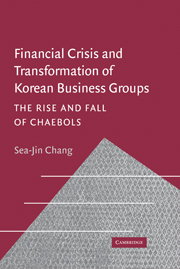Book contents
- Frontmatter
- Contents
- Preface
- 1 Introduction
- 2 The Evolution of Chaebols
- 3 Chaebols' Diversified Business Structure
- 4 Vertical Integration of Chaebols
- 5 The Capital Structure of Chaebols
- 6 Chaebols' Ownership and Governance Structure
- 7 The Restructuring of Chaebols
- 8 Conclusion
- Appendixes
- 1 Data Used in this Book
- 2 Comparing the Profitability of Group-affiliated Companies and Independent Companies
- 3 Profitability of Group-affiliated Firms
- 4 The Impact of Vertical Integration in Chaebols
- 5 Determinants of the Capital Structure of Chaebols
- 6 Profitability and Stock Ownership of Affiliates
- 7 Intragroup Business Transactions and Ownership Structures of the Top Five Chaebols
- 8 Key Economic Statistics
- Notes
- References
- Index
2 - Comparing the Profitability of Group-affiliated Companies and Independent Companies
Published online by Cambridge University Press: 05 January 2010
- Frontmatter
- Contents
- Preface
- 1 Introduction
- 2 The Evolution of Chaebols
- 3 Chaebols' Diversified Business Structure
- 4 Vertical Integration of Chaebols
- 5 The Capital Structure of Chaebols
- 6 Chaebols' Ownership and Governance Structure
- 7 The Restructuring of Chaebols
- 8 Conclusion
- Appendixes
- 1 Data Used in this Book
- 2 Comparing the Profitability of Group-affiliated Companies and Independent Companies
- 3 Profitability of Group-affiliated Firms
- 4 The Impact of Vertical Integration in Chaebols
- 5 Determinants of the Capital Structure of Chaebols
- 6 Profitability and Stock Ownership of Affiliates
- 7 Intragroup Business Transactions and Ownership Structures of the Top Five Chaebols
- 8 Key Economic Statistics
- Notes
- References
- Index
Summary
This appendix compares the profitability of group-affiliated companies vis-à-vis independent companies. As a precedent, previous work (Chang and Choi, 1988) used the data of publicly traded Korean companies during 1975–84 to show that group-affiliated Korean firms, especially those affiliated with the top 4 groups, which clearly showed characteristics similar to those of multidivisional structure, performed better than independent firms did. These results were interpreted as evidence for the efficiency of business groups, which are able to minimize transactions costs prevalent in developing countries such as Korea (Williamson, 1975; Leff, 1978).
This appendix extend Chang and Choi (1988) to a more recent time frame (i.e., 1985–96), and compare the profitability of group-affiliated companies vis-à-vis independent companies with dummy variables that note group membership. Table A.2.1 shows the results based on all the firms in the sample (i.e., Sample A), and Table A.2.2 shows the results for Sample A′, which is based only on public firms. Sample A′ is comparable to Chang and Choi (1988), which was also based only on public firms. The prime interest in this appendix is to examine the signs of business group dummies after controlling all other independent variables that affect profitability. If the business group dummy variables are positive and significant, this result suggests that firms associated with business groups are more profitable than are comparable independent firms.
Although it is difficult to identify a single indicator for a firm's performance, this study used profitability to measure this variable.
- Type
- Chapter
- Information
- Financial Crisis and Transformation of Korean Business GroupsThe Rise and Fall of Chaebols, pp. 249 - 263Publisher: Cambridge University PressPrint publication year: 2003

